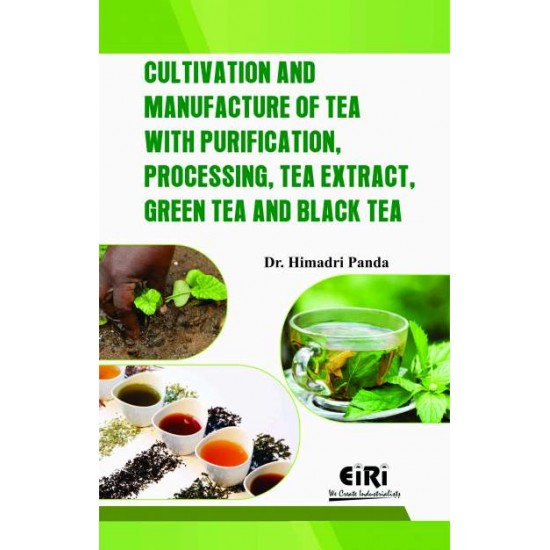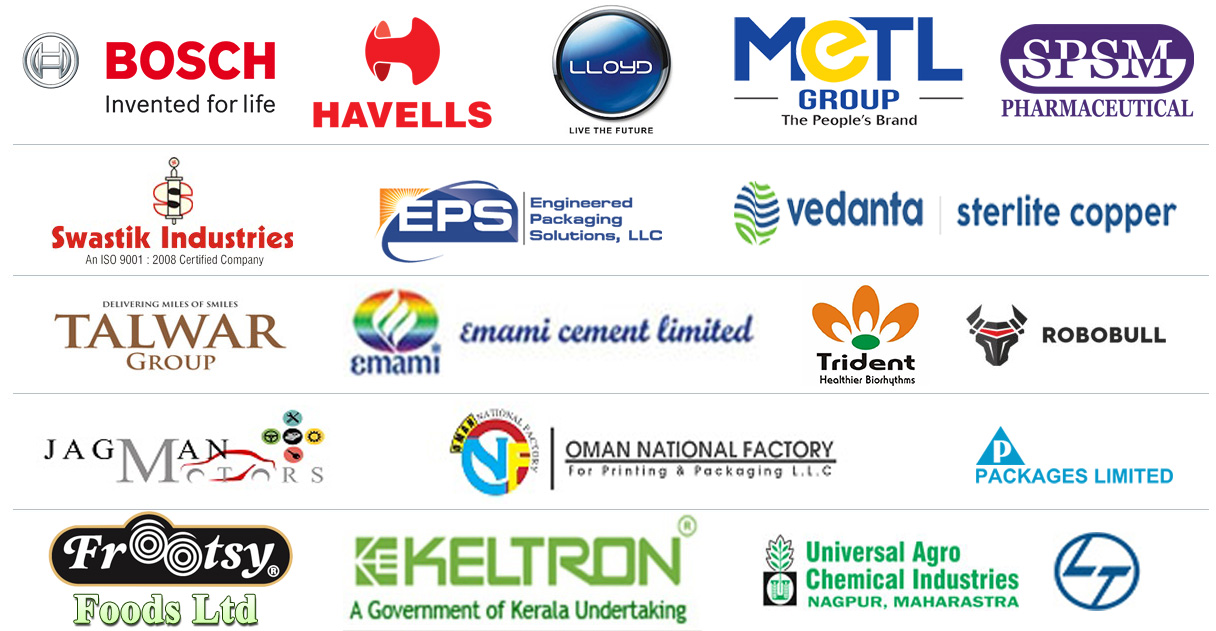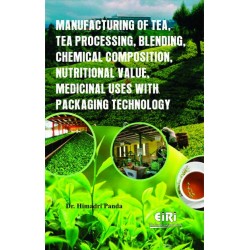Cultivation and Manufacture of tea with purification, processing, tea extract, green tea and black tea

- More than 40 years of experience
- Managed by expert industrial consultants
- ISO 9001-2015 Certified
- Registered under MSME, UAM No: DL01E0012000
- 24/5 Research Support
Get your quesries resolved from an industry expert. Ask your queries before report or book purchase. - Custom Research Service
Speak to the our consultant to design an exclusive study to serve your research needs. - Quality Assurance
All reports are prepared by highly qualified consultants & verified by a panel of experts. - Information Security
Your personal & confidential information is safe & secure.
- Origin of Tea
- Classification of Tea
- Initiation of Organized Tea Breeding In India
- Tea Breeding and Polyploidy
- Description of the Problem and Hypothesis
- Classification, Processing, Styles and Packaging of Tea
- Classification of Tea
- Tea Production Process
- Green tea manufacture
- Black and Oolong tea manufacture
- White tea manufacture
- Yellow and dark Tea manufacture
- Tea Styles
- Sorting and Packaging
- Ingredients of Tealeaves
- Vitamins and Minerals in Tea
- Tea Polyphenols
- Catechins
- Proanthocyanidins
- Theaflavins and Thearubigins
- Flavonols (FOG) and Flavones (FCG)
- Theanine
- Caffeine
- Description of tea plant
- Tea Varieties
- Cultivation conditions
- Climate and exposition:
- Type of soil
- Irrigation
- Tea plant reproduction
- Reproduction by seeds
- Reproduction by cuttings
- Tea tree pruning
- Tea crops association
- Tea harvest
- More information: Classes of tea.
- Tea manufacturing
- Collecting tea seeds
- Tea producing countries
- Planning the work
- Choosing which tea variety to plant
- Choosing a method for producing new tea plants
- (seeds, seedlings, or cuttings)
- How to produce new tea plants from seeds
- Location of the nursery
- Shade for the nursery
- Use of net houses
- Collecting soil for the nursery
- Filling the containers
- Planting the seeds
- Taking care of the seedlings
- How to produce new tea plants from cuttings
- Preparing mother bushes
- Calculate how many mother bushes to prepare based on Planting cuttings in a nursery
- Taking care of the cuttings
- Preparing the new field for tea
- Ringing and cutting down trees
- Planting green-manure bushes or grass
- Improving the soil
- Planting the tea into the new field
- Introduction
- Tea Species' Profile And Chemical Composition
- Tea Polyphenols
- Factors Influencing Tea Leaves Polyphenol Content
- During Processing
- Tea Leaf Catechins
- The Mechanism of Antioxidant Activity of Tea
- Polyphenols
- Bioavailability and Absorption of Tea Leaves
- Components
- Properties of Tea Polyphenols In Biological Systems
- The Mechanism of Antioxidant Activity of Tea
- Polyphenols
- Bioavailability And Absorption of Tea Leaves
- Components
- Properties of Tea Polyphenols In Biological Systems
- Tea Polyphenols In Body Weight Regulation
- Properties of Tea Polyphenols In Food
- Polyphenols
- Polyphenols in tea flush and green tea
- Polyphenols in black tea
- Flavonols and Flavonol Glycosides
- Flavones
- Phenolic Acids and Depsides
- Amino Acids
- Chlorophyll, Carotenoids and Other Pigments
- Carbohydrates
- Organic Acids
- Caffeine and Other Alkaloids
- Minerals
- Vitamins
- Enzymes
- Color
- Color of green tea
- Color of black tea
- Color of oolong tea
- Taste
- Taste of green tea
- Taste of black tea
- Taste of oolong tea
- Tea Cream and Tea Scum
- Steam Distillation
- Simultaneous Distillation Extraction (SDE)
- Solvent Extraction
- Headspace Analysis
- Static
- Dynamic
- Supercritical Fluid Extraction (SFE)
- Solid Phase Extraction (SPE)
- Identification and Quantification
- Formation of Tea Aroma
- Green Odor
- Floral Aroma
- Roasted and Nutty Aroma
- Off-flavor
- Stale flavor
- Photo-induced flavor
- Retort smell
- Smoky-burnt odor
- Aroma Characteristics of Various Teas
- Green Tea
- Pan-fired green tea
- Steamed green tea
- Scented tea
- Semi-fermented Tea
- Pouchong tea
- Oolong tea
- Black Tea
- Speciality Tea
- Post fermented tea
- Smoked tea
- Herbal Tea
- Development and Applications on Tea Aroma
- Separation of Chiral Compounds
- Separation and Identification of Glycosides
- Introduction
- Chemical Constituents of Tea
- Polyphenols
- Minerals
- Taste, Aroma and Colour of Tea
- Aroma of made tea
- Taste of made tea
- Colour of made tea
- Biological Activity of Tea Chemical Constituents
- Tea polyphenols and antioxidant activity
- Tea polyphenols and the risk of cancer
- Tea polyphenols and the risk coronary heart disease
- Antibacterial and antiviral effects of tea
- Anti-inflammatory effects of tea
- Diabetes and renal failure effects of tea
- Functionalities of tea and tea polyphenols in animal
- models
- Effects of tea polyphenols against other diseases
- Introduction
- Epigallocatechin
- Biological Activities of Green Tea-
- Neurodegenerative Diseases-
- Biochemical Properties
- Introduction
- Experimental
- Processing Method
- Results and Discussion
- (a) Panning
- (b) Cooling
- (c) Rolling
- (d) Roll-breaking
- Introduction
- Material and Methods
- Reagents
- Plant material
- Total polyphenol content
- Lipid substrates and antioxidants
- DPPHo radical scavenging method
- Statistical analysis
- Results
- Introduction
- Chemistry
- Flavour constituents
- Antioxidant mechanism
- Method of incorporation into food
- Application in food products
- Stability tests
- Peroxide value (PV)
- Conjugated dienes
- Thiobarbituric acid (TBA) value
- Oil Stability Index (OSI)
- Oxipres
- Schaal oven storage test
- Sensory evaluation
- Introduction
- Materials and methods
- Materials
- Experiment procedures and methods
- Determination of tea nutrition
- Determination of rehydration ratio
- Determination of colour
- Determination of organizational structure
- Assessment of sensory quality
- Results and discussion
- Comparison of rehydration
- Comparison of drying rate
- Comparison of colour
- Comparison of nutritional components
- Comparison of the organizational structure
- Comparison of sensory quality
- Introduction
- Chemistry and Biological Functions of Selenium
- Selenium Levels In Green Tea and Fortification
- Methods Normal Levels of Selenium
- Selenium Fortification
- Effect of Selenium Fortification on the Quality of
- Green Tea
- Biological Activities of Se-enriched Green Tea
- Antioxidant Activities
- Antitumor Effect
- Antimutagenic Effect
- Prebiotic Properties
- Safety of Se-enriched Green Tea
- The Standards of Se-enriched Green Tea
- Application of Se-enriched Green Tea
- Introduction
- Withering process
- Types of withering
- Chemical withering
- Physical withering
- Biochemical changes during chemical withering
- Proteins and amino acids
- Carbohydrates and simple sugars
- Lipids and fatty acids
- Catechins and enzyme activity
- Volatile flavor compounds (VFC)
- Chlorophyll
- Caffeine
- Carotenoids
- Roles of withering in different types of tea processing
- Effects of withering on other processing parameters
- in black tea production
- Maceration/rolling
- Fermentation (oxidation)
- Drying (firing)
- Storage of manufactured tea
- Fundamentals of good withering
- (Camellia sinensis)
- A simplified, hand-processed, Japan-style black tea
- Hand-processed green tea using a microwave oven and wok
- Materials and methods
- Chemicals and reagents
- Preparation of the test solution
- Determination of catechins, caffeine and GA
- Determination of amino acids
- Tea preparation for UPLC–QQQ–MS/MS
- UPLC-QQQ-MS/MS analysis
- Phytochemicals
- Alkaloids
- Flavones, flavonoids and flavanols
- Tannins
- Quinones
- Micro organisms evaluated in the antimicrobial
- activity of tea
- Staphylococcus aureus
- Escherichia coli
- Candida albicans
- Streptococcus faecalis
- Salmonella typhimurium
- Rodent Plasmodium parasites
- Life cycle of Plasmodium
- Serum proteins as markers of inflammation
- Tea samples
- Reagents
- The microorganisms used for in vitro antimicrobial assays of tea
- Qualitative determination of Phenolics
- Qualitative determination of Flavonoids
- Qualitative determination of terpenes
- Qualitative determination of cardiac glycosides
- Qualitative determination of cardenolides
- Qualitative determination of anthraquinones
- Qualitative determination of saponins
- Qualitative determination of tannins
- Determination of alkaloid content
- Determination of saponin content
- Determination of phenolic content
- Determination of tannin content
- Determination of carbohydrate content
- Determination of protein content
- Determination of lipid content
- Determination of anti-microbial effect of tea extracts
- Mice used for in vivo studies
- Plasmodium berghei isolate used for infection experiments
- Body weights measurements of mice treated with
- various dosages of green tea
- Determination of effect of tea extracts on mice infection
- Quantification of Plasmodium berghei
- Determination of PCV
- Determination of serum protein concentration in mice.
- Introduction
- Materials and Method
- Extraction procedures to obtain green tea extracts:
- Calculation
- Results
- Table : Key ingredients of tealeaves and their shares in the dry matter Planting tea seeds directly into the field
- Table General chemical components of tea leaves
- Table Tea Catechins and Their Structure
- Table Crystalline Shape and Physical Property of Tea Catechins
- Table Tea Theaflavin
- Table Contribution of Tea Drinking to the Requirements of Various Elements for Humans
- Table Enzymes Detected in Tea Flush
- Table Various Pigments (%) in Black Tea and Oolong Tea
- Table Taste and Threshold Value of Tea Components
- Table Aroma Constituents of Tea
- Table Compounds Occurring as Glycones of dically Bound Volatiles
- Table Configuration and Odor of Linalool Oxide Enantiomers.
- Table . Approximate % by Weight of Selected Tea Polyphenols (Catechins)
- Table . Composition of fresh tea flush (% dry eight)
- Table . Aroma constituents of tea
- Table Biochemical compounds responsible for aroma(flavor)
- Table Biochemical compounds responsible for Taste
- Table Biochemical compounds responsible for Color
- Table Importance of Various Polyphenols Present in Tea in Various Animal Models
- Table Total polyphenol content in purified green tea ethanol extracts
- Table Antioxidative effectivity coefficient (Aec) of purified green tea ethanol extracts
- Table DPPH scavenging activity of purified green tea ethanol extracts
- Table - Prospective applications of green tea extract
- Table Retention of the fresh leaves and fixation leaves
- Table Standard table of sensory assessment
- Table Effects of different drying technologies on the retention of nutrition
- Table Levels of selenium (valence state) in Se-enriched green tea
- Table Levels of selenium-containing compounds in Se-enriched green tea
- Table Regression equation,LOD and LOQ in the determination of analytes
How to Make Project Report?
Detailed Project Report (DPR) includes Present Market Position and Expected Future Demand, Technology, Manufacturing Process, Investment Opportunity, Plant Economics and Project Financials. comprehensive analysis from industry covering detailed reporting and evaluates the position of the industry by providing insights to the SWOT analysis of the industry.
Each report include Plant Capacity, requirement of Land & Building, Plant & Machinery, Flow Sheet Diagram, Raw Materials detail with suppliers list, Total Capital Investment along with detailed calculation on Rate of Return, Break-Even Analysis and Profitability Analysis. The report also provides a birds eye view of the global industry with details on projected market size and then progresses to evaluate the industry in detail.
We can prepare detailed project report on any industry as per your requirement.
We can also modify the project capacity and project cost as per your requirement. If you are planning to start a business, contact us today.
Detailed Project Report (DPR) gives you access to decisive data such as:
- Market growth drivers
- Factors limiting market growth
- Current market trends
- Market structure
- Key highlights
Overview of key market forces propelling and restraining market growth:
- Up-to-date analyses of market trends and technological improvements
- Pin-point analyses of market competition dynamics to offer you a competitive edge major competitors
- An array of graphics, BEP analysis of major industry segments
- Detailed analyses of industry trends
- A well-defined technological growth with an impact-analysis
- A clear understanding of the competitive landscape and key product segments
Need Customized Project Report?
- Ask for FREE project related details with our consultant/industry expert.
- Share your specific research requirements for customized project report.
- Request for due diligence and consumer centric studies.
- Still haven't found what you're looking for? Speak to our Custom Research Team
About Engineers India Research Institute:
Note: We can also prepare project report on any subject based on your requirement and country. If you need, we can modify the project capacity and project cost based on your requirement.
Our Clients

Our Approach
- Our research reports comprehensively cover Indian markets (can be modified as per your country), present investigation, standpoint and gauge for a time of five years*.
- The market conjectures are produced on the premise of optional research and are cross-accepted through associations with the business players
- We use dependable wellsprings of data and databases. What's more, data from such sources is handled by us and incorporated into the report
Why buy EIRI reports?
- Our project reports include detailed analysis that help to get industry Present Market Position and Expected Future Demand.
- Offer real analysis driving variables for the business and most recent business sector patterns in the business
- This report comprehends the present status of the business by clarifying a complete SWOT examination and investigation of the interest supply circumstance
- Report gives investigation and top to bottom money related correlation of real players/competitors
- The report gives gauges of key parameters which foresees the business execution





















